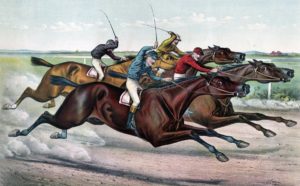Which is the smallest fence on the Grand National Course?
According to the Rules of Racing, with the exception of the Water Jump, which is jumped just once during the Grand National, all the fences on the National Course must be a minimum of 4’6″ high, measured on the take-off side. In fact, just three fences conform to the official minimum height, but one or two of them have still proved troublesome.
Historically, the first fence has claimed numerous victims, not because of its height, but because runners tend to approach it at a rate of knots. Indeed, in 2013, the starting position of the Grand National was moved closer to the first fence – thereby reducing the advertised distance by half a furlong – in an attempt to prevent runners building up a head of steam on their approach.
The seventh (and twenty-third) fence is, without question, the most famous of the smaller fences on the Grand National Course. It bears the name of ‘Foinavon’, who went on to win the 1967 Grand National at odds of 100/1 after avoiding a melee at the fence on the second circuit. Of course, the Foinavon fence does immediately follow the formidable Becher’s Brook, so can catch out the unwary,
By contrast, fourteenth (and thirtieth, and final) fence is probably the most innocuous of all the smaller fences on the National Course. Billy Barton did famously fall at the final fence in the 1928 Grand National to leave another 100/1 outsider, Tipperary Tim, to finish alone but, on the whole, final fence fallers are something of a rarity.
 The history of the Grand National dates back to 1839, while the Cheltenham Gold Cup and Champion Hurdle were inaugurated in 1924 and 1927, respectively. However, in the best part of a century since the three races have co-existed, no horse has ever won all three. In fact, in all that time, just two horses have won the Cheltenham Gold Cup and Grand National and just one has won the Champion Hurdle and Cheltenham Gold Cup.
The history of the Grand National dates back to 1839, while the Cheltenham Gold Cup and Champion Hurdle were inaugurated in 1924 and 1927, respectively. However, in the best part of a century since the three races have co-existed, no horse has ever won all three. In fact, in all that time, just two horses have won the Cheltenham Gold Cup and Grand National and just one has won the Champion Hurdle and Cheltenham Gold Cup.